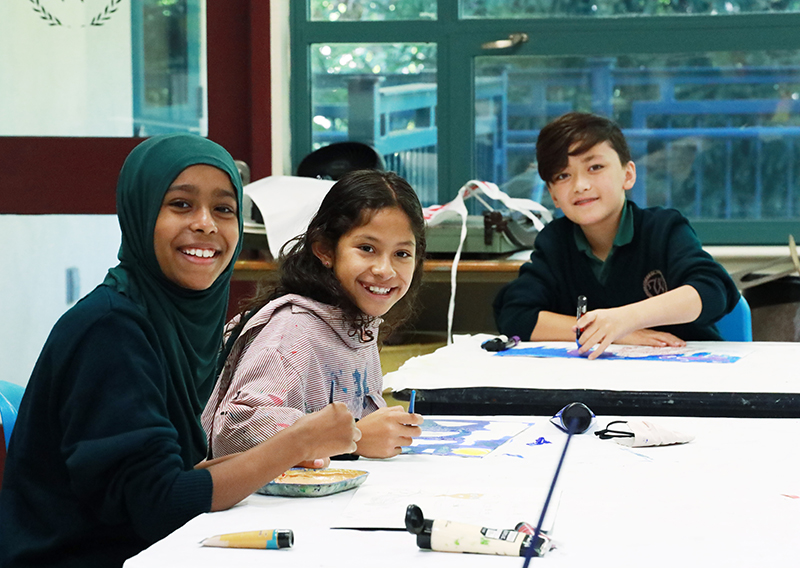The Power of Creativity in Education

“One of the key benefits of art integration is the way it encourages learners to stretch and explore their thinking.” – National Arts in Education Association.
Art in education doesn’t just promote creativity in learning; it creates self-assured, well-rounded students. Students who receive an integrated arts education are more confident, inclusive, expressive, and collaborative learners.
The lifelong benefit of arts education goes beyond the final product students create. The true benefit of arts in education is the process of performing, developing, or creating. Arts education allows students to recognize and understand complexity, enabling them to use reason to reach a conclusion when there is not a clear right or wrong answer to a problem. It enables students to be responsible decision-makers and emotionally intelligent human beings.
Education grants students opportunities for academic success. Arts in education highlights the effectiveness of creativity on holistic development. Students nurture independence, self-respect, and collaboration skills through an arts education.
The creativity in art education leaves room for innovation. It allows them to take ownership of their learning. Nurturing a student’s holistic development is powerful and contributes to an impactful education. An integrated arts education will enable students to navigate complications in life with confidence and creativity.
Benefits of Arts Education
The benefits of art in education for students are vast. From fostering creativity in learning to developing cognitive and social-emotional skills, students gain much from arts in the classroom.
Enhancing cognitive skills
New studies link the arts to pivotal cognitive development for children. One 2018 study demonstrated that drawing had a dramatic effect on memory, outperforming writing, visualizing, and other retention techniques. The benefits of arts education include improved school performance, not just personal development. This evidence proves that students who partake in art education don’t just hone their creativity when they are in the classroom. Students reap the benefits of arts education because it improves many essential cognitive skills needed throughout their lives.
Nurturing emotional intelligence
Art provides a medium for students to experience and process emotions and develop emotional intelligence. It fosters empathy, inclusion, collaboration, and emotional regulation. Art education teaches students how to work with others, regulate emotions, and problem-solve when difficulties arise.
Fostering social skills and collaboration
Arts education usually involves collaboration and enhances students’ understanding of social skills. Whether it’s group theater or a chorus, artistic endeavors provide opportunities to work as a team.
Art education also allows students to experience and understand cultural differences and fosters communication among diverse individuals. Students learn to work together effectively regardless of the project, performance, or product.
Bringing Creativity into the Classroom
According to The National Education Association, “Arts integration isn’t just about sketching a picture; it’s an approach to teaching.” This approach strengthens students’ learning ability and prepares them for success in life.
Integrating arts across different subjects
Incorporating music, drama, or art within the curriculum improves comprehension of complex subjects. For example, students use shapes and drawings during math to better understand complex geometry concepts. Students act out or dictate important parts of a play or book in English. They color or create visual displays during science to better understand experiments and hypotheses.
Some innovative ways art is used in teaching include:
- Utilizing art as a warm-up or ice-breaker
- Incorporating art into a pre or post-assessment
- Utilizing art as a cultural or personal connection among peers
- Integrating art as a means to hypothesize before instruction
- Breaking into groups to act out or narrate a story
- Including art to increase differentiation in teaching
- Using art to draw upon background or preexisting knowledge of a subject
Talent shows, dance classes, choral performances, and art and poetry contests are central to life at Westminster School. The school offers weekly classes in music and art for all grades, with orchestra as an option for grades 3-8. Every student performs in a drama production each year, culminating in a 7th-grade Shakespeare play and an 8th-grade Broadway musical. Academic projects always include a creative component, and field trips to area museums and theaters enhance students’ passion for all areas of the arts.
Do you value the role of an arts education for your child?
Unfortunately, many arts programs lack support. Many people don’t understand the extreme and transformative value of arts in education.
If art education is important to you, show your support! Advocate for an education that is right for you and your child. Support local art education initiatives by visiting Americans for the Arts.
Other ways you can show your support for art in education include:
- Volunteering your time
- Sharing about the cause
- Contacting elected officials
- Reaching out to school leaders
- Enroll in a school where there is a focus on arts education
Arts education contains many benefits for students’ education and their future. Art in education strengthens students’ cognitive, social, emotional, and developmental skills. It can make the difference between a student who can process the stress of life and engage in school and those who cannot.
For decades, the arts have been a core component at Westminster School, woven into the fabric of daily life, resulting in self-discovery, confidence-building, and life-long enrichment. Art serves as an avenue for right-brain, outside-of-the-box thinking, as well as the development of the human spirit. Make art education a priority in your child’s education and experience the impact on their learning!

